2016 Honda Civic Sedan EX with Honda Sensing - Review by Carey Russ +VIDEO
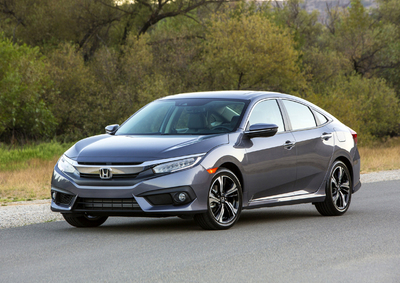 2016 Honda Civic sedan |
Bigger, better and safer than ever
DRIVING DOWN THE ROAD WITH CAREY RUSS
• SEE ALSO: Honda Research and Buyers Guide
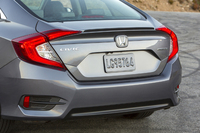 2016 Honda Civic sedan |
The Civic was Honda's entry vehicle into the American automotive market back in 1973, and the nameplate is still with us. Nearly 22 million examples have been sold worldwide since its debut, with over ten million in the US. Nearly seven million of those have been built in plants in the US and Canada. And the tenth generation has arrived for 2016.
That tenth-generation Civic is one of the most-changed in its history. While its exterior styling builds on that of its immediate predecessor, nearly everything underneath -- unibody structure, suspension, drivetrain, and interior -- has changed. The sedan was the first to debut, followed more recently by a coupe. A hatchback will return in the near future.
The Civic's reputation was built on fuel economy, engineering innovation, and build quality. The original was a subcompact hatchback, and its exemplary fuel economy made it popular during the gas crises of the 1970s. The CVCC engine further added to the Civic's appeal in 1975 as it could meet emissions requirements without use of a catalytic converter and run on less-expensive leaded regular gasoline. Since then, the Civic has grown in size and has produced multiple offshoots, including the Accord (in 1976), sedan and wagon bodystyles, and performance versions including the Si, CRX, and in some markets Type R.
Compared to the 2012-15 version, the new Civic sedan is 2.9 inches longer on a 1.2-inch greater wheelbase, 1.9 inches wider, 0.8 inches lower -- and lighter in weight. What hasn't been changed is a shorter list than what has. The unibody structure sees much greater use of high-strength and ultra-high strength steel and redesigns for greater crashworthiness and improved weather sealing and interior quiet. There is a new multilink independent rear suspension, and improved bushings. Not only competitive middle-class compacts but luxury-brand cars as well were benchmarked in design and testing for interior design and quiet and ride and handling.
There are two new engines. Standard in the entry LX and core-model EX is a 2.0-liter twincam four with i-VTEC valve control. Its maximum 158 horsepower and 138 lb-ft of torque are channeled to the front wheels via either a six-speed manual (LX only) or CVT automatic transmission. In the EX-T is found the first turbocharged and direct-injected engine to be used in a Civic, with 1.5 liters capacity for 174 hp and 162 lb-ft. It's matched to a beefed-up CVT in the new EX-T (turbo) model, the EX-L(eather), and new top-of-the-line Touring, the first luxury Civic.
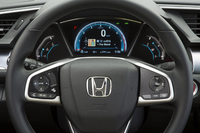 2016 Honda Civic sedan |
Surprisingly for press fleet specifications, my test Civic sedan for the past week was not a Touring, but an EX with the Honda Sensing package of electronic safety systems including adaptive cruise control, collision-mitigation braking, forward collision warning, lane-keeping assist, and road departure mitigation. As the core model, the EX would be expected to have everything people really need and much of what they want. And it does. Proximity-sensitive "Smart Entry", pushbutton start/stop, a power moonroof, Honda's LaneWatch passenger-sider mirror-mounted blind-spot system, heated side mirrors, Bluetooth connectivity, SMS messaging functionality, and more are standard. Honda doesn't complicate life with myriad options and packages. The "EX with Honda Sensing" is considered a trim level (within a trim level).
On the road, no surprises. The new Civic feels close to the previous, and is quick enough for everyday traffic situations, engaging to drive, and sips fuel. I got 34 mpg for the week, and 40 for one highway stint. Which was not done at the EPA test simulated 50 mph… highway traffic here is either 70-plus or barely moving.
Since a friend recently bought a 2015 Civic EX sedan, I was able to do a direct comparison between the two. The `16 looks bigger, only because it is. It's also noticeably roomier inside, if only in inches here and there. There is about three cubic feet more interior space. The new one is a bit quicker, and the mileage I got during my week is similar to what he gets. The tenth-generation Civic is more evolutionary than revolutionary and no demerits for that. Don't mess up a good thing!
APPEARANCE: At one point, strictly by coincidence, a neighbor's eighth-generation Civic sedan, my friend's 2015, and my 2016 test car were parked in a line in front of my house. The evolution of Civic sedan styling was apparent -- the profiles are similar if proportions change a bit, the size increases, and styling details get ever more complex. The front has an origami look, all neatly-folded planes and angles dominated by a thick, bright chromed crossbar and long, low headlamps. Rectangular faux brake ducts in the lower fascia are similar to recent Acura styling (and Chiti-era Ferraris of the early 1960s and the more recent F360). The roofline extends to the rear in the manner of more-expensive German coupe-sedans. The large, angular C-shaped taillights are the new Civic's most defining feature. I've seen that shape before, but on what science-fiction movie spaceship?
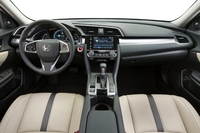 2016 Honda Civic sedan |
COMFORT: Going from the old to the new, the new Civic is noticeably roomier, if not by a lot. And if the outside is more "spaceship", the interior is less so as the previous double-layer instrument panel has been replaced by a more conventional one. Even in EX trim it looks upscale of its modest price point, and materials and fit and finish are first-rate. Here, seating is cloth, with manual adjustment. But front seat comfort is better than expected in the class, and visibility is very good thanks to narrower A-pillars. Instrumentation is electronic, and in EX and above a seven-inch information display combining digital speedometer with tachometer and information is situated in front of the driver, flanked by engine temperature and fuel gauges. No more multi-level spaceship control center, and more knee room for that. Audio, information, phone, HondaLink, and Bluetooth streaming and phone app functions are controlled via a central touchscreen. Controls, such as they are, on the screen are tiny and hard to use with the car in motion.
Fortunately there are also better controls for those systems on the steering wheel. Windows and mirrors are power-adjustable, and the driver's-side mirror has an outboard convex section to reduce the blind spot on that side. The blind spot on the passenger side is covered by the LaneWatch camera, which displays in the center screen and automatically turns on when a right turn is signaled -- or at the touch of a button on the end of the turn signal stalk. There are useful storage and beverage spaces throughout the cabin. The multi-configurable center console is a standout. There is also a forward console partially hidden below the center stack. Rear seat room is surprisingly good, especially for knees. The trunk is usefully larger, and a space-saver spare is found underneath.
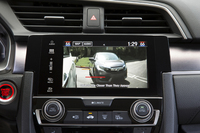 2016 Honda Civic sedan |
SAFETY: The 2016 Honda Civic sedan is expected to get top ratings from both NHTSA and IIHS crash tests. Its unibody structure was designed with safety in mind, and surrounds passengers with carefully-constructed elements to mitigate crash energy. The usual air bags and safety belts are supplemented by four-wheel antilock disc brakes with electronic brake-force distribution and brake assist and a sophisticated stability assistance system with traction control that also works with the steering assist to help the driver steer out of trouble. Electronic-bases systems such as forward collision and lane-departure warning, road-departure and collision braking mitigation, are optionally available in all models except the Touring, where they are standard.
RIDE AND HANDLING: Bigger and roomier usually means more weight but not here. Careful design and increased use of lightweight but strong materials significantly improves structural rigidity and decreases weight. The redesign and careful attention to aerodynamics, along with strategic use of soundproofing also means lower interior noise levels, for improved passenger comfort and reduced fatigue. The suspension is fully-independent, with MacPherson struts in front and a new multilink system in the rear. Careful attention to detail and improved bushings and a well-designed electric power steering system mean nimble handling and precise steering, with good ride comfort. A long highway trip shouldn't be overly tiring, and the new Civic is happily at home on the scenic route as well.
PERFORMANCE: Less weight, more power means better performance on less unleaded regular. The new 2.0-liter naturally-aspirated four is a typical Honda engine, with aluminum alloy block and head, dual overhead cams, and four valves per cylinder controlled by the i-VTEC variable lift, duration, and phasing system to optimize performance, economy, and emissions. On paper is seems peaky, with its maximum 158 horsepower developed at 6500 rpm and 138 lb-ft of torque at 4200 rpm. The i-VTEC system ensures that there is good midrange torque, and the CVT makes good use of that. Like all such, it's programmed to help improve fuel economy and so keeps the engine in its best range for that most of the time. That's not the best range for power, for quick acceleration or hill climbing, but for those, use either L (low) for steep grades at reasonably low speeds or S (second?) for on-ramp acceleration. With a 34-mpg average for the week and 40 during one highway stint, I have no complaints about fuel use.
CONCLUSIONS: In the case of the 2016 Honda Civic sedan, bigger doesn't mean heavier but does mean better.
SPECIFICATIONS
2016 Honda Civic Sedan EX with Honda Sensing
Base Price $ 22,040
Price As Tested $ 22,875
Engine Type DOHC 16-valve aluminum alloy inline 4-cylinder with i-VTEC® variable valve lift and timing
Engine Size 2.0 liters / 122 cu. in.
Horsepower 158 @ 6500 rpm
Torque (lb-ft) 138 @ 4200 rpm
Transmission CVT
Wheelbase / Length 106.3 in. / 182.3 in.
Curb Weight 2799 lbs.
Pounds Per Horsepower 17.7
Fuel Capacity 12.39 gal.
Fuel Requirement 87 octane unleaded regular gasoline
Tires 215/55R16 93H m+s Firestone FT140
Brakes, front/rear vented disc / solid disc, ABS, EBD, VSA standard
Suspension, front/rear independent MacPherson strut / independent multi-link
Drivetrain transverse front engine, front-wheel drive
PERFORMANCE
EPA Fuel Economy - miles per gallon city / highway / observed 31 / 41 / 34
0 to 60 mph 8.2 sec
OPTIONS AND CHARGES
Destination Charge $ 835


